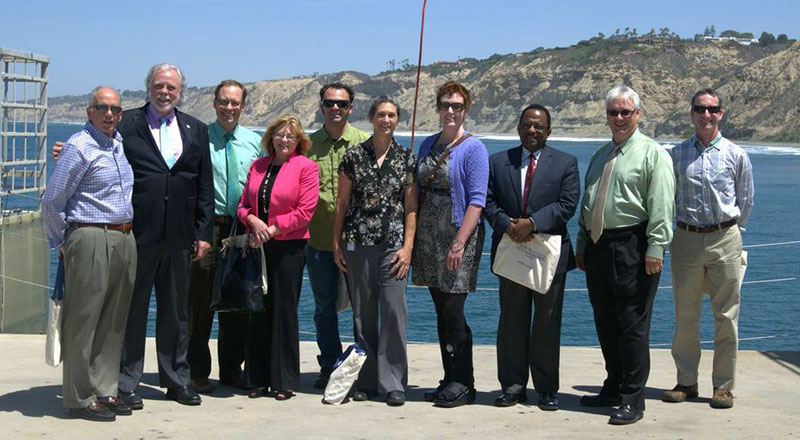Leading the Way to Coastal Stewardship
Scripps, Port, and Water Control Board look to future of San Diego’s regional ocean management and water quality
By:
- Cindy Clark
Published Date
By:
- Cindy Clark
Share This:
Article Content

Leaders of the Port of San Diego and San Diego Regional Water Quality Control Board at Scripps Pier.
Leaders of the Port of San Diego and members of the San Diego Regional Water Quality Control Board engaged with scientists at Scripps Institution of Oceanography, UC San Diego, this week to set a course for enhanced collaboration among the region’s top environmental entities. The three groups share mutual goals of environmental stewardship, coastal protection and monitoring, and improved ocean water quality, focusing on benefits for society and the environment.
The Port of San Diego is the fourth largest of the 11 ports in California and was created by the state legislature in 1962. The Port is an economic engine, an environmental steward of San Diego Bay and the surrounding tidelands, and a provider of community services and public safety.
The San Diego Regional Water Quality Control Board develops and enforces water quality objectives and implements plans to protect the area's waters while recognizing local differences in climate, topography, geology, and hydrology. The team strives to protect and enforce the many uses of water, while addressing the varied and complex needs of industry, agriculture, municipal districts, and the environment.
Together, with Scripps Oceanography, the groups discussed rising sea levels and related coastal hazards and the ocean’s impacts on human health. Scripps’s strength is drawn from its legacy programs of monitoring coastal waters and providing useful scientific data to policy makers and the public.
Scripps Oceanography operates the Shore Stations Program that collects temperature and salinity measurements at 10 sites along California’s coast. Established in 1916, this monitoring program remains one of the world's longest operating ocean observation programs and the longest on the Pacific Rim. With its volunteer observers, Scripps is able to expand regular sampling with bimonthly analysis to establish baseline information for the California coast. As part of its commitment to public outreach, Scripps provides free access to the data on the Shore Stations Program website and the Southern California Coastal Ocean Observing System website. Additional monitoring led by Scripps is provided through the Coastal Data Information Program (link: https://cdip.ucsd.edu/), which has built a database of sand-level change and waves at California beaches, including during El Niño events and local beach nourishment projects.
Scripps Director Margaret Leinen said this field visit with coastal research groups builds on the unique relationship among Scripps, the Port, the Regional Board, the College of Sciences at San Diego State University, and Hubbs-SeaWorld Research Institute, all working partners in the Center for Bay and Coastal Dynamics (CBCD). The scientific expertise from Scripps and the CBCD, merged with policy and oversight efforts by the Port of San Diego and the San Diego Regional Water Quality Control Board, support and protect California’s treasured coast and local ocean waters – a $22 billion annual economic engine.
Share This:
You May Also Like
UC San Diego is Strengthening U.S. Semiconductor Innovation and Workforce Development
Technology & EngineeringStay in the Know
Keep up with all the latest from UC San Diego. Subscribe to the newsletter today.



